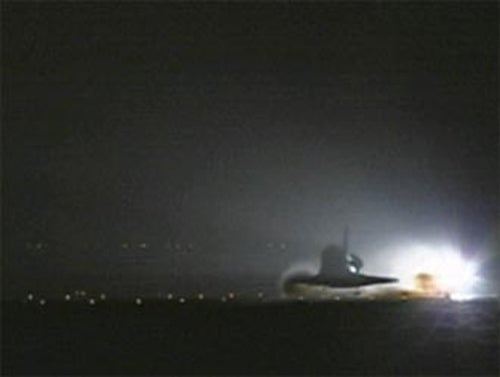“Welcome home, Discovery.”
At 5:11 a.m. PDT today, NASA let out a collective sigh of relief and then celebrated. The space shuttle Discovery, after nearly 14 days in orbit, had landed safely on runway 22 at Edwards Air Force Base in California. The touchdown brought an end to the first shuttle mission since the Columbia disaster in February 2003.
“We’re happy to be back, and we congratulate the whole team for a job well done,” reported Commander Eileen Collins.
“I’m thinking about resigning my position in favor of Eileen Collins,” joked NASA Administrator Michael Griffin from Florida’s Kennedy Space Center (KSC). “We are pleased here today.”
| Please return your tray tables to the upright position |
| What is the procedure for a safe space-shuttle landing? The process begins hours before touching down.
|
After two passes by KSC were called off due to rain and lightning, flight controllers selected Edwards, where the weather forecast indicated favorable landing conditions. The spacecraft approached the desert runway at a steep nose-down dive. Approximately 1 mile (1.6 kilometers) before reaching the strip’s edge, Discovery flared to a shallow nose-up, tail-down position for landing. Following touchdown, Discovery rolled for 1.5 miles (2.4 km) before coming to a stop. This was the 6th nighttime and 50th overall shuttle landing at the base.
Besides the opportunities at Kennedy and Edwards, NASA also had a deorbit plan for the Northrup Strip at White Sands Space Harbor in New Mexico.
NASA’s “Return to Flight” mission was active. Discovery resupplied the Expedition 11 crew aboard the International Space Station (ISS) — the first shuttle to do so since 2002. Discovery also brought back about 3 tons of trash and broken equipment from ISS. During 2 spacewalks, the astronauts replaced a faulty ISS gyroscope and added a spare parts platform to its exterior. During an extra day in orbit, the crew enjoyed the window view and exercised normal flight operations.
In response to the Columbia disaster, the Discovery astronauts tested shuttle repair techniques. Using a laser camera on a 50-foot (15-meter) boom, they examined the heat shield tiles on the shuttle’s belly. The ISS crew assisted by imaging Discovery’s underside as the shuttle docked with the space station.
The mission members also performed an unexpected task, the first-ever external repair job in orbit. Mission Specialist Steve Robinson ventured underneath the shuttle to work on the heat shield. Canadarm, a robotic arm attached to the ISS, hoisted a portable foot that carried him to the left side of Discovery’s belly. As the robotic arm positioned him, Robinson removed two gap fillers protruding between heat-shielding tiles.
After the successful return, what is the crew looking forward to? Before landing, Mission Specialist Charles Camarda said that after visiting with family, “We all want to get a great shower, get cleaned up, and have a great dinner.”
The shuttle will be moved to Kennedy Space Center after 7 or 8 days in California.











